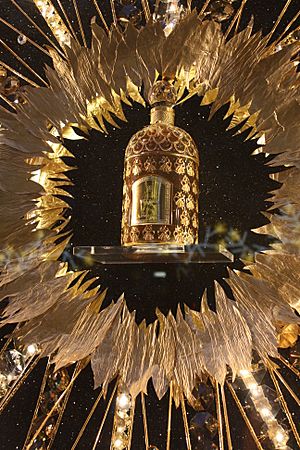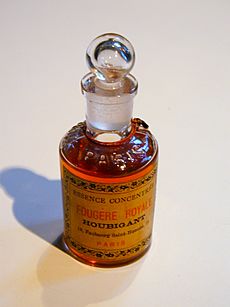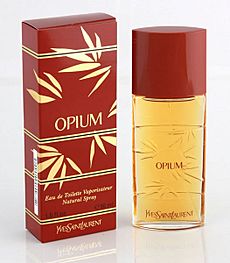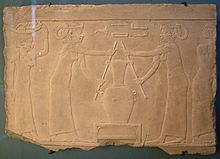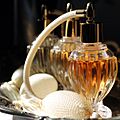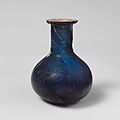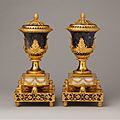Perfume facts for kids
Perfume is a liquid that gives people, things and rooms a good smell. It is made of oils which give off scent to the surrounding air. The odoriferous compounds that make up a perfume can be manufactured synthetically or extracted from plant or animal sources.
Perfumes were used in the earliest human civilizations. Modern perfumery began in the late 19th century with the commercial synthesis of aroma compounds such as vanillin or coumarin. The artificial compounds gave a wider ranger of scents than natural materials.
Perfume smells more when temperature is warmer. So people put it on the neck, wrist and back of the knee, because these parts are warmer. Eau de Cologne is a type of perfume which can be splashed on the body. It is not so concentrated as the usual perfumes.
Contents
Describing a perfume
The precise formulae of commercial perfumes are kept secret. Even if they were widely published, they would be dominated by such complex ingredients and odorants that they would be of little use in providing a guide to the general consumer in description of the experience of a scent. Nonetheless, connoisseurs of perfume can become extremely skillful at identifying components and origins of scents in the same manner as wine experts.
The most practical way to start describing a perfume is according to the elements of the fragrance notes of the scent or the "family" it belongs to, all of which affect the overall impression of a perfume from first application to the last lingering hint of scent.
The trail of scent left behind by a person wearing perfume is called its sillage, after the French word for "wake", as in the trail left by a boat in water.
Olfactive families
The grouping perfumes can never be completely objective or definitive. Many fragrances contain aspects of different families. Even a perfume designated as "single flower" will have subtle undertones of other aromatics. There are hardly any true unitary-scent perfumes consisting of a single aromatic material.
The family classification is a starting point to describe a perfume, but does not fully characterize it.
Traditional categories
The traditional categories which emerged around 1900:
- Single Floral: Fragrances dominated by a particular flower; in French called a soliflore. Example: Serge Lutens Sa Majeste La Rose.)
- Floral Bouquet: Compound of several flower scents. Examples: Houbigant Quelques Fleurs, Jean Patou Joy.
- Amber or "Oriental": Large class featuring sweet, slightly animalic scents of ambergris or labdanum, often combined with vanilla, tonka bean, flowers and woods. Can be enhanced by camphorous oils and incense resins, evoking Victorian era "Oriental" imagery. Traditional examples: Guerlain Shalimar, Yves Saint Laurent Opium, Chanel Coco Mademoiselle.
- Woody: Fragrances dominated by woody scents, typically agarwood, sandalwood, cedarwood, and vetiver. Patchouli, with its camphoraceous smell, is commonly found in these perfumes. Traditional examples: Myrurgia Maderas De Oriente, Chanel Bois des Îles. Modern: Balenciaga Rumba.
- Leather: A family of fragrances featuring honey, tobacco, wood and wood tars in the middle or base notes and a scent that alludes to leather. Traditional examples: Robert Piguet Bandit, Balmain Jolie Madame.
- Chypre: Meaning Cyprus in French, this includes fragrances built on bergamot, oakmoss, and labdanum. Named after oakmoss scent (chypre powder), popularized with the success of François Coty's Chypre (1917). Modern example: Guerlain Mitsouko.
- Fougère: Meaning fern in French, built on a base of lavender, coumarin and oakmoss, with a sharp herbaceous and woody scent. Named for Houbigant's Fougère Royale, many men's fragrances belong to this family. Modern examples: Fabergé Brut, Guy Laroche Drakkar Noir, Penhaligon's Douro.
Modern
Since 1945, new categories have emerged to describe modern scents, due to great advances in the technology of compound design and synthesis, as well as the natural development of styles and tastes:
- Bright Floral: Combining Single Floral & Floral Bouquet traditional categories. Example: Estée Lauder Beautiful.
- Green: Lighter, more modern interpretation of the Chypre type, with pronounced cut grass, crushed green leaf and cucumber-like scents. Examples: Estée Lauder Aliage, Sisley Eau de Campagne, Calvin Klein Eternity.
- Aquatic, Oceanic, Ozonic: The newest category, first appearing in 1988 Davidoff Cool Water (1988), Christian Dior Dune (1991). A clean smell reminiscent of the ocean, leading to many androgynous perfumes. Generally contains calone, a synthetic discovered in 1966, or more recent synthetics. Also used to accent floral, oriental, and woody fragrances.
- Citrus: An old fragrance family that until recently consisted mainly of "freshening" eau de colognes, due to the volatility of citrus scents. Development of newer fragrance compounds has allowed for the creation of more tenacious citrus fragrances. Example: Penhaligon's Quercus.
- Fruity: Featuring fruits other than citrus, such as peach, cassis (black currant), mango, passion fruit, and others. Example: Ginestet Botrytis.
- Gourmand: Scents with "edible" or "dessert-like" qualities, often containing vanilla, tonka bean, and coumarin, as well as synthetic components designed to resemble food flavors. A sweet Example: Thierry Mugler's Angel (sweet).
Fragrance wheel
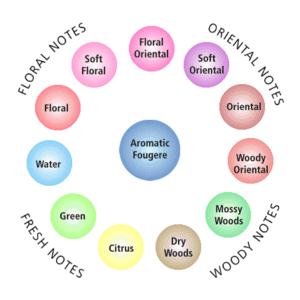
This newer classification method is widely used in retail and the fragrance industry, created in 1983 by the perfume consultant Michael Edwards. The new scheme simplifies classification and naming, as well as showing the relationships among the classes.
The five main families are Floral, Oriental, Woody, Aromatic Fougère, and Fresh, the first four from the classic terminology and the last from the modern oceanic category. Each of these are divided into subgroups and arranged around a wheel. In this scheme, Chanel No.5, traditionally classified as an aldehydic floral, is placed under the Soft Floral sub-group, while amber scents are within the Oriental group. Chypre perfumes are more ambiguous, having affinities with both the Oriental and Woody families. For instance, Guerlain Mitsouko is under Mossy Woods, but Hermès Rouge, a more floral chypre, is under Floral Oriental.
History
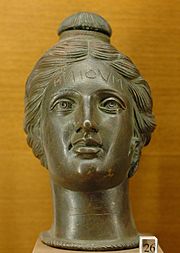
The word perfume used today derives from the Latin per fumum, meaning "through smoke." Perfumery, or the art of making perfumes, began in ancient Mesopotamia and Egypt and was further refined by the Romans and Persians.
The world's first recorded chemist is considered to be a woman named Tapputi, a perfume maker who was mentioned in a cuneiform tablet from the 2nd millennium BC in Mesopotamia. She distilled flowers, oil, and calamus with other aromatics then filtered and put them back in the still several times.
In 2005, archaeologists uncovered what are believed to be the world's oldest perfumes in Pyrgos, Cyprus. The perfumes date back more than 4,000 years. The perfumes were discovered in an ancient perfumery. At least 60 stills, mixing bowls, funnels and perfume bottles were found in the 43,000-square-foot (4,000 m2) factory. In ancient times people used herbs and spices, like almond, coriander, myrtle, conifer resin, bergamot, as well as flowers.
The Arabian alchemist, Al-Kindi (Alkindus), wrote in the 9th century a book on perfumes which contained more than a hundred recipes for fragrant oils and medical substances.
The Persian chemist Avicenna introduced the process of extracting oils from flowers by means of distillation, the procedure most commonly used today. He first experimented with the rose. Until his discovery, liquid perfumes were mixtures of oil and crushed herbs or petals, which made a strong scent. Rose water was more delicate, and immediately became popular.
The art of perfumery was known in western Europe since the 13th or 14th centuries. By the 18th century, aromatic plants were grown in France, Sicily, and Italy.
Images for kids
-
Ancient Egyptian perfume vessel in shape of a monkey; 1550-1295 BC; faience; height: 6.5 cm, width: 3.3 cm, depth: 3.8 cm; Metropolitan Museum of Art (New York City)
-
Original Eau de Cologne flacon 1811, from Johann Maria Farina, Farina gegenüber
-
Resins in perfumery include myrrh
-
Itar (herbal perfume) vendor on the street of Hyderabad, India, who can compose an original perfume for the customer
-
A "perfume organ", where perfumers play around with hundreds of essences, in Grasse
-
An assorti of counterfeit perfumes (in a "kiosk" store)
-
Potpourri, by Edwin Austin Abbey, 1899
-
Ancient Egyptian perfume vase in shape of an amphoriskos; 664–630 BC; glass: 8 × 4 cm (3.1 × 1.5 in); Metropolitan Museum of Art (New York City)
-
Late Hellenistic glass gold-band mosaic alabastron (perfume bottle); 1st century BC; glass and gold leaf; Metropolitan Museum of Art
-
Roman perfume bottle; 1st century AD; glass; 5.2 x 3.8 cm; Metropolitan Museum of Art
-
British Rococo perfume vase; circa 1761; soft-paste porcelain; overall: 43.2 × 29.2 × 17.8 cm; Metropolitan Museum of Art
-
British Neoclassical pair of perfume burners; probably circa 1770; derbyshire spar, tortoiseshell, and wood, Carrara marble base, gilded brass mounts, gilded copper liner; 33 × 14.3 × 14.3 cm; Metropolitan Museum of Art
See also
 In Spanish: Perfume para niños
In Spanish: Perfume para niños


